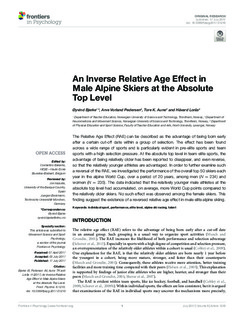| dc.contributor.author | Bjerke, Øyvind | |
| dc.contributor.author | Pedersen, Arve Vorland | |
| dc.contributor.author | Aune, Tore Kristian | |
| dc.contributor.author | Lorås, Håvard | |
| dc.date.accessioned | 2017-10-02T11:33:02Z | |
| dc.date.available | 2017-10-02T11:33:02Z | |
| dc.date.created | 2017-08-04T10:31:17Z | |
| dc.date.issued | 2017 | |
| dc.identifier.issn | 1664-1078 | |
| dc.identifier.uri | http://hdl.handle.net/11250/2457709 | |
| dc.description.abstract | The Relative Age Effect (RAE) can be described as the advantage of being born early after a certain cut-off date within a group of selection. The effect has been found across a wide range of sports and is particularly evident in pre-elite sports and team sports with a high selection pressure. At the absolute top level in team elite sports, the advantage of being relatively older has been reported to disappear, and even reverse, so that the relatively younger athletes are advantaged. In order to further examine such a reversal of the RAE, we investigated the performance of the overall top 50 skiers each year in the alpine World Cup, over a period of 20 years, among men (N = 234) and women (N = 235). The data indicated that the relatively younger male athletes at the absolute top level had accumulated, on average, more World Cup points compared to the relatively older skiers. No such effect was observed among the female skiers. This finding suggest the existence of a reversed relative age effect in male elite alpine skiing. | nb_NO |
| dc.language.iso | eng | nb_NO |
| dc.publisher | Frontiers Media | nb_NO |
| dc.rights | Navngivelse 4.0 Internasjonal | * |
| dc.rights.uri | http://creativecommons.org/licenses/by/4.0/deed.no | * |
| dc.title | An Inverse Relative Age Effect in Male Alpine Skiers at the Absolute Top Level | nb_NO |
| dc.type | Journal article | nb_NO |
| dc.type | Peer reviewed | nb_NO |
| dc.description.version | publishedVersion | nb_NO |
| dc.source.volume | 8 | nb_NO |
| dc.source.journal | Frontiers in Psychology | nb_NO |
| dc.identifier.doi | 10.3389/fpsyg.2017.01210 | |
| dc.identifier.cristin | 1484142 | |
| dc.description.localcode | © 2017 Bjerke, Pedersen, Aune and Lorås. This is an open-access article distributed under the terms of the Creative Commons Attribution License (CC BY). The use, distribution or reproduction in other forums is permitted, provided the original author(s) or licensor are credited and that the original publication in this journal is cited, in accordance with accepted academic practice. No use, distribution or reproduction is permitted which does not comply with these terms. | nb_NO |
| cristin.unitcode | 194,67,80,0 | |
| cristin.unitcode | 194,65,30,0 | |
| cristin.unitname | Institutt for lærerutdanning | |
| cristin.unitname | Institutt for nevromedisin og bevegelsesvitenskap | |
| cristin.ispublished | true | |
| cristin.fulltext | original | |
| cristin.qualitycode | 2 | |

